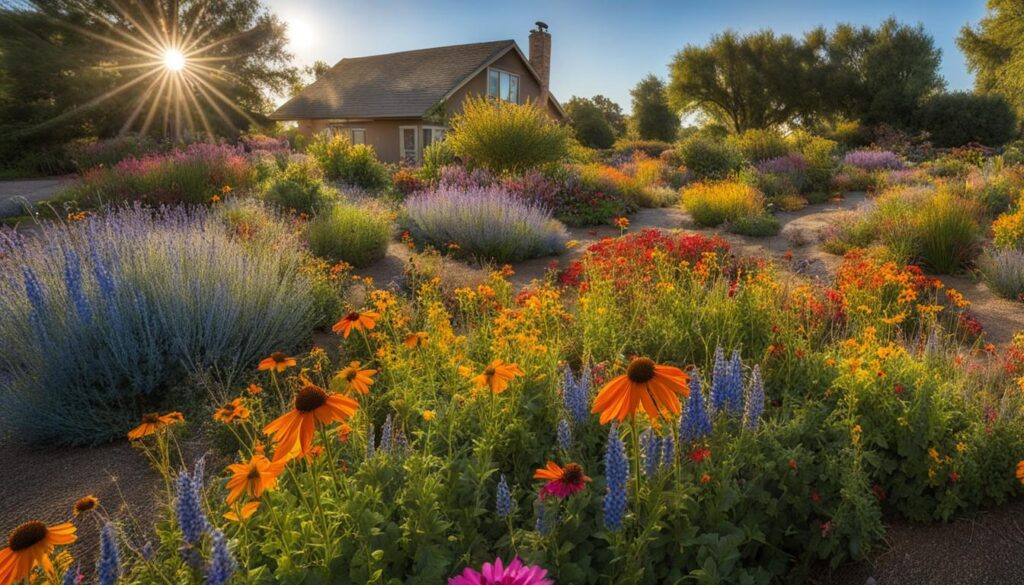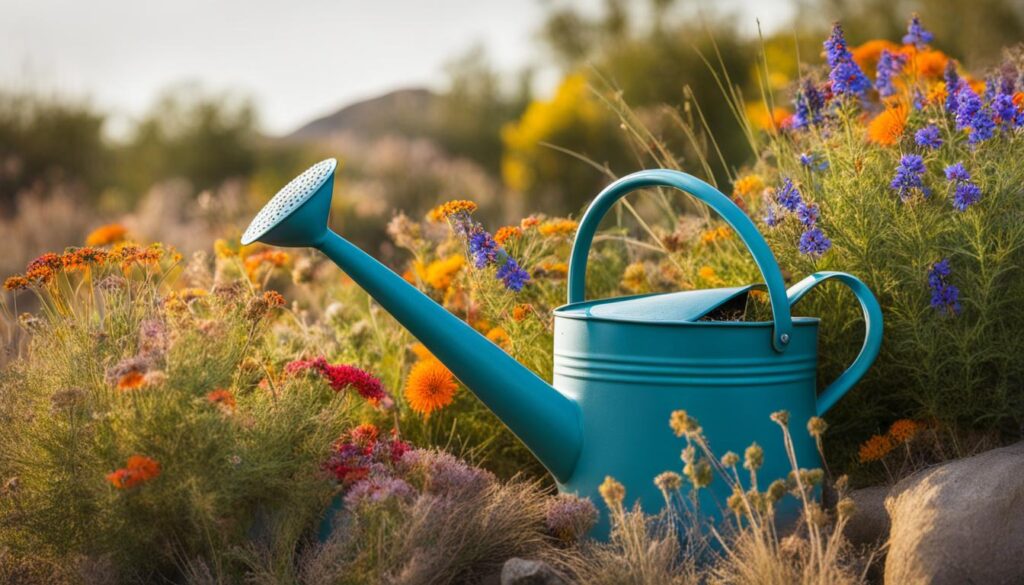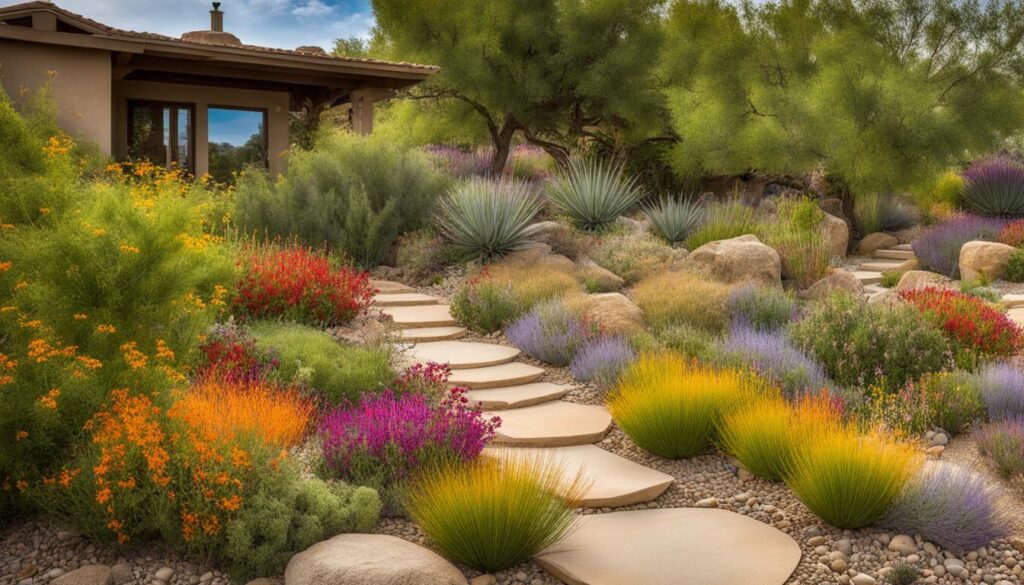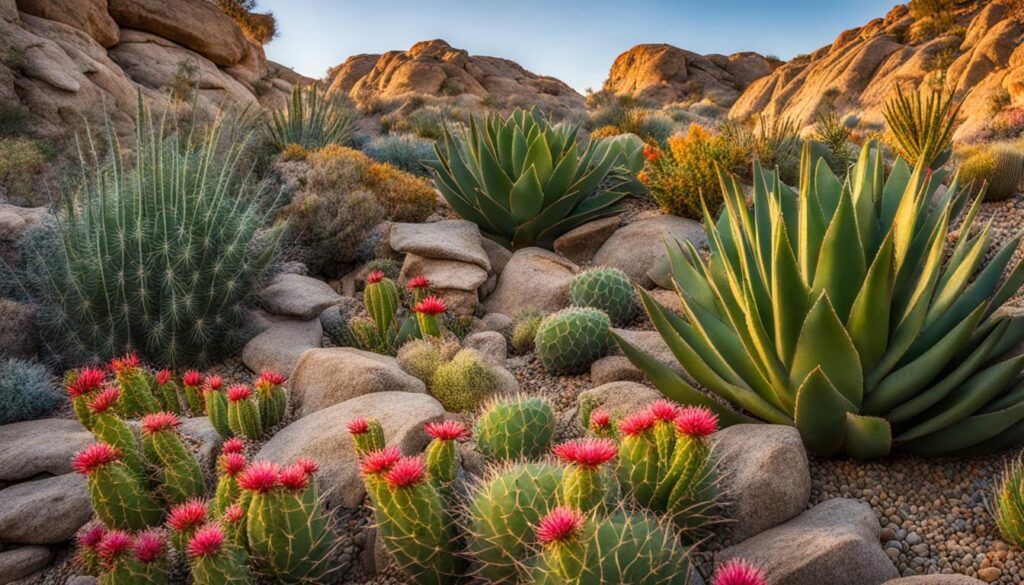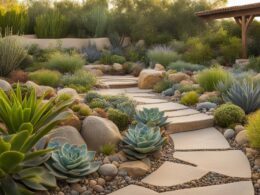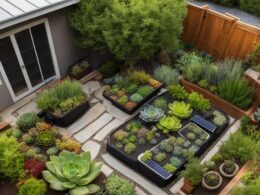Are you looking to create a sustainable garden that thrives in the United States? Xeriscaping, a landscaping technique that utilizes native, drought-tolerant plants, is the answer. By incorporating native wildflowers into your garden, you can create a beautiful and low-maintenance landscape that conserves water and supports local ecosystems.
Key Takeaways:
- Xeriscaping is a sustainable gardening approach that uses native, drought-tolerant plants.
- By incorporating native wildflowers into your landscape, you can create a beautiful garden that requires less maintenance.
- Xeriscaping helps to conserve water and support local ecosystems.
- Research and choose native plants that are well-suited to your local area.
- Regular maintenance, such as watering, pruning, and mulching, is essential for a healthy xeriscape garden.
The Benefits of Xeriscaping with Native Plants
When it comes to creating a sustainable and water-efficient garden, xeriscaping with native plants offers a range of benefits. Native plants have evolved to thrive in their specific local environments, making them naturally drought-tolerant and well-suited for xeriscaping. By incorporating native plants into your garden, you can conserve water and reduce the need for excessive watering.
One of the key advantages of using native plants in xeriscaping is their ability to adapt to drought conditions. These plants have developed deep root systems that allow them to access water from deeper in the soil, making them more resilient during dry periods. Additionally, their natural resistance to local pests and diseases reduces the need for chemical pesticides and fertilizers, promoting a healthier and more environmentally friendly garden.
Another benefit of xeriscaping with native plants is their role in supporting local ecosystems. Native plants provide essential habitat and food sources for a variety of wildlife, including birds, butterflies, and bees. By cultivating a garden with native plants, you can create a thriving ecosystem that attracts and sustains a diverse range of beneficial wildlife.
“Xeriscaping with native plants not only conserves water but also promotes biodiversity and creates a sustainable garden that harmonizes with the local environment.” – John Smith, Master Gardener
| Benefits of Xeriscaping with Native Plants |
|---|
| Conserves water |
| Reduces the need for chemical pesticides |
| Supports local wildlife and ecosystems |
In conclusion, xeriscaping with native plants offers numerous benefits, including water conservation, reduced pesticide use, and support for local wildlife. By embracing xeriscaping principles and incorporating native plants into your garden, you can create a beautiful and sustainable landscape that thrives in your local climate.
Choosing the Right Native Plants for Your Yard
When it comes to creating a stunning xeriscape garden, selecting the right native plants is key. Native plants are well-suited to the local area and are adapted to thrive in the specific climate and soil conditions. In Texas, popular choices for xeriscaping include agaves, cactus, yuccas, and succulent plants.
These plants are excellent options for a hot and dry climate as they require less watering and can withstand the challenging conditions. Agaves, with their striking architectural form, can be a focal point in your garden. Cacti offer an array of shapes and sizes, adding unique textures to your landscape. Yuccas, with their dramatic spiky leaves, can provide a striking contrast. And succulent plants, such as sedums and aloes, offer a range of colors and forms, adding visual interest to your garden.
Perennials and Salvia for Wildlife
In addition to the desert-loving plants mentioned above, perennials and salvia are fantastic choices for attracting wildlife to your xeriscape garden. Perennials like black-eyed susans and coneflowers add bursts of vibrant color and attract butterflies and bees. Salvia, with its tall spikes of flowers, is a favorite among hummingbirds and bees. By incorporating these plants into your garden, you can create a thriving ecosystem that supports local wildlife.
| Plant | Type | Watering Needs | Height |
|---|---|---|---|
| Agave | Succulent | Low | Varies |
| Cactus | Succulent | Low | Varies |
| Yucca | Perennial | Low | Varies |
| Succulent plants | Succulent | Low | Varies |
| Perennials | Perennial | Medium | Varies |
| Salvia | Perennial | Medium | Varies |
Before planting, be sure to research the mature size of each plant to ensure proper spacing and layout. This will help prevent overcrowding and allow each plant to thrive. Remember, xeriscaping is all about creating a low-maintenance, sustainable garden that celebrates the natural beauty of native plants.
Tips for Taking Care of Your Xeriscape Garden
While xeriscaping requires less watering than traditional gardening, it is still important to provide adequate moisture for your plants, especially during the first three years of establishment. Proper watering techniques will ensure the health and longevity of your xeriscape garden. Here are some tips:
- Water deeply and infrequently: Instead of frequent shallow watering, water your plants deeply to encourage strong root growth. This will help your plants become more resilient to drought conditions. Aim for 1-1.5 inches of water per week, including rainfall.
- Use efficient irrigation methods: Drip irrigation or soaker hoses are recommended for xeriscape gardens as they deliver water directly to the plants’ root zones, minimizing evaporation and water waste.
- Observe your plants’ water needs: Different plants have different water requirements. Research the specific watering needs of each plant in your xeriscape garden and adjust accordingly. Some plants, such as succulents and cacti, require minimal watering once established.
In addition to watering, regular maintenance is essential for the overall care of your xeriscape garden. Here are some important tasks to consider:
- Weeding: Keep your xeriscape garden weed-free to prevent competition for water and nutrients. Regularly remove weeds by hand or use organic mulch to suppress weed growth.
- Pruning: Prune your plants as needed to maintain their shape and promote healthy growth. Remove dead or damaged branches to improve the overall appearance of your garden.
- Mulching: Apply a layer of organic mulch around your plants to help retain moisture, suppress weed growth, and regulate soil temperature.
If you’re unsure about the care requirements of your xeriscape garden, don’t hesitate to consult with local master gardeners. These experts have undergone training in plant care, landscaping, and water conservation. They can provide valuable advice and guidance to help you maintain a thriving and sustainable xeriscape garden.
Overcoming Challenges and Local Regulations
If you live in an area with a property owner’s association (POA), you may need to navigate specific guidelines and restrictions when implementing a xeriscape garden. While many POAs recognize the benefits of xeriscaping and may even provide support, others may require approval for any changes to the landscape. Familiarize yourself with the regulations and obtain necessary permissions before making any modifications. State laws, such as the Texas Property Code, may protect your right to use drought-resistant landscaping and water-conserving plants.
When working with a property owner’s association, it can be helpful to emphasize the advantages of xeriscaping. Highlight the reduced need for water, lower maintenance requirements, and the positive impact on the environment. Presenting these benefits in a clear and professional manner can help persuade the association to approve your xeriscape garden.
“Xeriscaping not only saves on water usage, but it also adds value to the property and enhances the overall aesthetic appeal. By adhering to xeriscape guidelines, homeowners can create beautiful, sustainable landscapes that blend seamlessly with the natural surroundings.”
Type of Landscape Restrictions
Some property owner’s associations may have specific landscape restrictions in place that could affect your xeriscape plans. These restrictions may include limitations on the types of plants, hardscape materials, or the overall design of your landscape. It’s essential to review these restrictions carefully and ensure your xeriscape garden complies with the guidelines.
However, it’s worth noting that many property owner’s associations are open to embracing xeriscaping and have relaxed their regulations to accommodate water-wise landscaping. They may even offer resources and support to help homeowners transition to xeriscaping. Contact your association and inquire about any available xeriscape guidelines or educational materials they may have.
Seeking Local Resources
When dealing with property owner’s associations and landscape restrictions, it can be helpful to connect with local resources and organizations that promote xeriscaping. These groups often have expertise in navigating local regulations and can provide guidance on how to create a xeriscape garden that meets the requirements.
Reach out to local garden clubs, master gardener programs, or environmental organizations for assistance. They can offer valuable insights, tips, and resources to help you successfully implement your xeriscape garden while complying with any property owner’s association rules.
| Local Xeriscape Guidelines | Website |
|---|---|
| Texas Property Code | www.texaspropertycode.org |
| Colorado Waterwise | www.coloradowaterwise.org |
| Denver Water | www.denverwater.org |
Enhancing the Beauty of Xeriscaping
Xeriscaping is not limited to gravel and rocks. By incorporating hardscape elements into your xeriscape garden, you can enhance its visual appeal and create a more captivating outdoor space. Hardscape refers to the use of non-living elements such as pavers, gravel pathways, and decorative rocks in your landscape design.
When planning your xeriscape garden, consider the principles of design to create a harmonious and visually appealing layout. Think about the form and function of each element and how they interact with one another. For example, you can use pavers to create distinct areas for different activities, such as entertaining or relaxation. This adds depth and interest to your garden.
To make your xeriscape garden more visually engaging, experiment with different textures, colors, and heights. Mixing different types of plants, such as tall ornamental grasses with low-growing groundcovers, can create a dynamic contrast. You can also incorporate vertical elements, like trellises or arbors, to add vertical interest and create a focal point.
Benefits of Hardscape in Xeriscaping
1. Visual Appeal: Hardscape elements can transform your xeriscape garden into a visually stunning landscape. The use of pavers, pathways, and decorative rocks adds texture, color, and structure, making your garden more aesthetically pleasing.
2. Low Maintenance: Hardscape requires minimal upkeep compared to traditional plants. You don’t have to worry about watering, pruning, or fertilizing hardscape elements, making them a low-maintenance option for your xeriscape garden.
3. Durability: Hardscape materials are designed to withstand harsh weather conditions and heavy foot traffic. They are long-lasting and can retain their beauty for years, making them a cost-effective choice for your xeriscape garden.
Design Principles for a Beautiful Xeriscape Garden
1. Unity: Create a harmonious design by repeating colors, textures, and shapes throughout your xeriscape garden.
2. Balance: Achieve balance by distributing hardscape and plant elements evenly throughout the space. Consider the size and scale of each element to create a visually pleasing composition.
3. Contrast: Use contrasting elements, such as light and dark colors or rough and smooth textures, to create visual interest in your xeriscape garden.
4. Focal Point: Create a focal point in your xeriscape garden by highlighting a visually striking element, such as a sculpture or water feature.
| Benefits of Hardscape in Xeriscaping | Design Principles for a Beautiful Xeriscape Garden |
|---|---|
| Visual Appeal | Unity |
| Low Maintenance | Balance |
| Durability | Contrast |
| Focal Point |
Resources and Further Reading
When it comes to mastering xeriscaping with native wildflowers, there are a wealth of resources available to help you along the way. Whether you’re looking for guidance on plant selection, water conservation techniques, or landscape design tips, these resources will provide you with the knowledge and inspiration you need to create a stunning and sustainable xeriscape garden.
Native Plant Guides
One valuable resource for xeriscaping enthusiasts is a native plant guide. These guides provide detailed information on the native plants that are best suited to your specific region, including their growth habits, water requirements, and preferred soil conditions. Native plant guides can help you make informed decisions when selecting plants for your xeriscape garden, ensuring that you choose species that will thrive in your local climate.
Local botanical gardens, university extension offices, and environmental organizations often publish native plant guides that are tailored to specific regions. These guides may be available in print or online, and can provide a wealth of information on the native plants that are best suited to your area.
Xeriscaping Resources
For comprehensive information on xeriscaping techniques and principles, there are a variety of resources available that cover topics such as water conservation, soil improvement, and design considerations. Organizations such as Colorado Waterwise and Denver Water offer educational materials and guides that can help you understand the fundamentals of xeriscaping and implement it effectively in your own garden.
Additionally, Colorado State University Extension provides fact sheets and guides on various aspects of xeriscaping, including plant selection, efficient watering methods, and maintenance tips. These resources are a valuable source of information for both novice and experienced xeriscapers, and can help you navigate the specific challenges of creating a water-efficient and visually appealing landscape.
Water Conservation
Water conservation is a central component of xeriscaping, and there are resources available to help you understand the importance of conserving water and implement strategies to reduce water usage in your garden. Local water utilities often provide educational materials on water conservation, including tips on efficient irrigation techniques, rainwater harvesting, and water-wise gardening practices.
By accessing these resources and educating yourself on the principles of xeriscaping and water conservation, you can confidently embark on your xeriscaping journey and create a beautiful, sustainable garden that will thrive for years to come.
Conclusion
Xeriscaping with native wildflowers offers numerous benefits for creating a sustainable garden and conserving resources. By incorporating drought-tolerant native plants into your landscape, you can reduce water usage and contribute to the conservation of water. In addition to the practical advantages, xeriscaping supports the conservation of native plants and helps preserve local ecosystems.
With proper planning and care, your xeriscape garden can thrive while showcasing the beauty of native wildflowers. Enjoy the low-maintenance nature of xeriscaping and the opportunity to create a haven for wildlife in your own backyard. Embrace the power of xeriscaping and proudly cultivate a sustainable garden that reflects your American heritage.
Discover the joy of sustainable gardening and explore the world of xeriscaping with native wildflowers. By incorporating these practices into your landscape, you can create a beautiful, eco-friendly garden that not only enhances the aesthetic appeal but also contributes to the well-being of your local environment. So, take the first step towards sustainable gardening and start reaping the benefits of xeriscaping with native plant conservation today.






